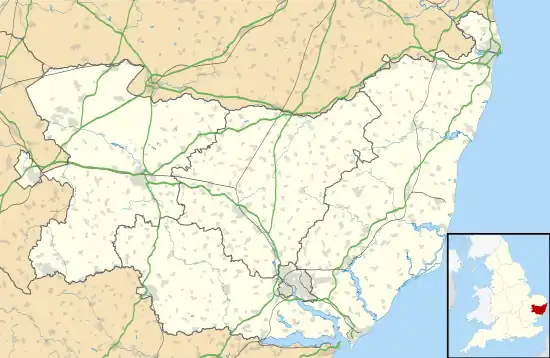Moyse's Hall
Moyse's Hall is a building in the Suffolk town of Bury St Edmunds. It is a Grade I listed building[1] and is thought to have been originally built circa 1180.[2][3] Now a museum, it has been used for many purposes, including as the town's jail, police station, hostel, parcels office and as a workhouse.[4]
| Moyse’s Hall | |
|---|---|
 | |
| Location | Bury St Edmunds, Suffolk |
| Coordinates | 52.2463°N 0.7130°E |
| Built | ca. 1180 |
| Architectural style(s) | Norman architecture |
Listed Building – Grade I | |
| Designated | 7 August 1952 |
| Reference no. | 1076931 |
 Location of Moyse’s Hall in Suffolk | |
History
The early usage of Moyse's Hall is often said to have been as a synagogue or 'Jew's house' but this is a matter of contention.[5][6] The origin of the name is unclear and a topic of debate, with its earliest known usage to be in 1328.[3][5] Some suggesting that it was once owned by a Jew named after a corruption of Moses, although no records show a contemporary Jew with this name or similar in Bury St Edmunds.[6] Others point to concurrent gentile families in the area bearing the name of Moys, Moises, Mose and Moyse.[5]
There is limited evidence to suggest that the building was in use as an inn and tavern from 1300 up to 1600.[2]
The building has undergone several restorations including one in 1858, funded in part by the town municipality, 36 years before the building came into the care of the town.[7] A tower clock was installed in the 1860.[8] A refurbishment extending the museum into run down buildings at the rear was carried out in 2000-2002.
Museum
On 31 May 1899 Lord John Hervey opened the building as Moyse's Hall Museum.
The museum is home to the Gershom-Parkington clock collection,[8] and artefacts concerning the Red Barn Murder, as well as important finds such as an aestel found in Drinkstone.[9] Works by artists such as Mary Beale, Sybil Andrews and Angelica Kauffman are also in the collection.
See also
- Jew's House, Lincoln
References
- Historic England. "Moyse's Hall, Bury St Edmunds (1076931)". National Heritage List for England. Retrieved 15 December 2022.
- "St Edmundsbury Borough Council - Moyse's Hall Museum, Bury St Edmunds - The History of the Building". www.stedmundsburychronicle.co.uk. Retrieved 2022-12-15.
- Samuel, Edgar. "Was Moyse's Hall, Bury St. Edmunds, a Jew's House?". Transactions & Miscellanies (Jewish Historical Society of England). 25: 43–47 – via JSTOR.
- "Devil that haunted Moyses Hall". Bury Free Press. 27 May 1949. p. 10.
- Haes, Frank. "MOYSE HALL, BURY ST. EDMUNDS. WHENCE ITS NAME—WHAT IT WAS—WHAT IT WAS NOT". Transactions (Jewish Historical Society of England). 3: 18–24 – via JSTOR.
- "Moyse's Hall". The Jewish Chronicle. 27 March 1896. pp. 23–24. Retrieved 28 December 2022.
- Bevan, Beckford (6 March 1894). "Moyse's Hall". Bury and Norwich Post. p. 7.
- Morrison, Rhoda (26 October 2018). "Gershom-Parkington clock collection gives staff at Moyse's Hall Museum in Bury St Edmunds an extra challenge as the clocks go back". Suffolk News. Retrieved 9 February 2023.
- "Treasure finds in England top 1,000 for first time". BBC News. 23 November 2017. Retrieved 10 February 2023.